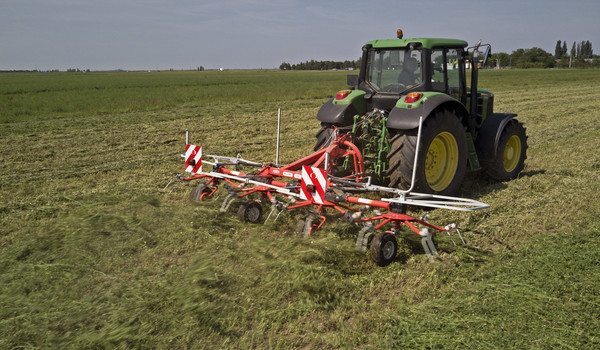
High performance for Maschio Gaspardo haymaking machines
In its full-line dedicated to haymaking, Maschio Gaspardo offers a range of high performance tedders and windrowers. Elia Pro is a machine specialised in the spreading of forage, specifically designed at the Cremona headquarters to perform, in the most diverse operating conditions, delicate work with a good forward speed of the tractor in order to enhance the quality of the product in the field.
The optimal overlapping of the tines and the possibility of varying the spreading angle ensure accurate management of the product according to the various requirements, while the front steering and floating linkage, assisted by the shock-absorbing arms, significantly improves the machine's manoeuvrability. A front support wheel has the task of adapting the implement to the morphology of the terrain, thus avoiding possible contamination of the forage. Available with working widths between 5.3 and 7.7 metres and with 4 or 6 rotors (each of which is equipped with six arms with spreading tines), Elia Pro is equipped with oil-bath gearboxes, anti-wrap covers on the wheels and a sturdy protection frame.
The Golia Pro 2 H semi-mounted double-rotor model stands out among the windrowers made by the Venetian company. As the manufacturer itself explains in a technical note, this is a machine designed to work at good speed on vast expanses of land. The working width starts from a minimum of 6.7 metres to a maximum of 7.3 metres, with a power requirement for the tractor of 60 horsepower or more.
Versatility is another great plus of the Maschio Gaspardo windrower, which is popular for its ability to work with all the main forage crops. Golia Pro 2 H is equipped with two rotors arranged in a staggered manner, one on the left and one on the right, with the possibility of creating one or two clean and regular swaths: a single row is obtained by setting the rotors near the central drawbar, while extending them outwards creates two separate swaths.
For agile manoeuvring, a technology known as "forced steering" - a tie rod connected to the two-point headstock - allows the wheels to be tilted, reducing the steering angle and adapting the trajectory of the implement to the tractor's track width.








